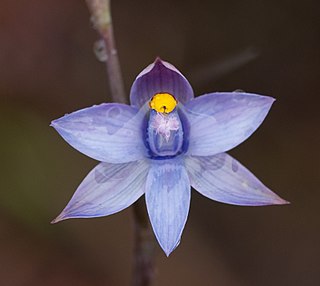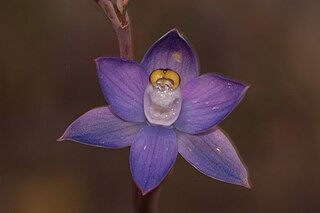
Dipodium, commonly known as hyacinth orchids, is a genus of about forty species of orchids native to tropical, subtropical and temperate regions of south-east Asia, New Guinea, the Pacific Islands and Australia. It includes both terrestrial and climbing species, some with leaves and some leafless, but all with large, often colourful flowers on tall flowering stems. It is the only genus of its alliance, Dipodium.

Dipodium punctatum, commonly known as the blotched hyacinth-orchid, is a leafless orchid that is a native to eastern and south-eastern continental Australia. In summer it produces a tall flowering stem with up to sixty pale to bright pink flowers with heavy red blotches. A widespread and common species it is often confused with D. roseum and some authorities regard it as a synonym of D. squamatum.

Dipodium elegantulum, commonly known as the elegant hyacinth orchid, is a leafless orchid that is endemic to Queensland. In spring and summer it has up to sixty pale to dark pink flowers with a few darker spots and streaks near the tips, on a tall flowering stem.

Dipodium roseum, commonly known as rosy hyacinth-orchid or pink hyacinth-orchid, is a leafless saprophytic orchid found in east and south-eastern Australia. In summer it produces a tall flowering stem with up to fifty pale pink flowers with small, dark red spots. A widespread and common species it is often confused with D. punctatum but has darker, less heavily spotted flowers.

Dipodium variegatum, commonly known as the slender hyacinth-orchid, or blotched hyacinth-orchid, is a leafless mycoheterotrophic orchid that is endemic to south-eastern Australia. It forms mycorrhizal relationships with fungi of the genus Russula.
Dipodium campanulatum, commonly known as the bell-flower hyacinth orchid, is a leafless mycoheterotroph orchid that is endemic to south-eastern Australia. In summer it has up to thirty five white flowers with large, dark red spots and blotches.

Dipodium stenocheilum, commonly known as tropical hyacinth-orchid, is a leafless saprophytic orchid that is endemic to northern Australia. For most of the year the plant is dormant but in summer it produces a tall flowering stem with up to twenty five white flowers with purple spots and a mauve labellum.

Dipodium atropurpureum, commonly known as the purple hyacinth orchid, is a mostly leafless mycoheterotrophic orchid that is endemic to New South Wales. In summer it has up to forty dark pinkish purple to reddish purple flowers with darker spots and blotches on a tall flowering stem.
Dipodium pulchellum is an almost leafless orchid that is endemic to north-east New South Wales and south-east Queensland in Australia. Up to forty pink flowers with darker blotches are borne in summer and winter on flowering spikes up to 90 cm (40 in) long.
Caladenia fuliginosa is a plant in the orchid family Orchidaceae and is endemic to the Yorke Peninsula in South Australia. It is a ground orchid with a single hairy leaf and a single relatively large, creamy-yellow flower, sometimes with reddish lines. The flowers have a smell resembling hot metal.

Thelymitra malvina, commonly called the mauve-tufted sun orchid, is a species of orchid, native to eastern Australia and New Zealand. It has a single large, fleshy leaf and up to twenty-five blue to mauve flowers with pink or mauve tufts on top of the anther.

Thelymitra batesii, commonly called the plump sun orchid, is a species of orchid that is endemic to South Australia. It has a single fleshy, channelled, dark green leaf and up to eight mauve to bluish purple flowers that are pinkish with darker stripes on the back. The unopened flower buds are distinctly plump.

Thelymitra holmesii, commonly called the blue star sun orchid, is a species of orchid that is endemic to south-eastern Australia. It has a single long, narrow, fleshy leaf and up to nine purplish blue to mauve flowers with a deeply notched lobe on top of the anther.

Thelymitra spiralis, commonly called curly locks, is a species of orchid in the family Orchidaceae and endemic to the south-west of Western Australia. It has a single erect leaf, spiralling around the flowering stem and up to three pink, reddish, purplish or blue flowers with two large yellow or orange ear-like arms on the sides of the column.
Thelymitra uliginosa, commonly called southern curly locks or swamp curly locks, is a species of orchid in the family Orchidaceae and endemic to the south-west of Western Australia. It has a single erect leaf, spiralling around the flowering stem and a single small pink, mauve, blue or purplish flower with darker veins and sometimes darker blotches. There are two narrow, yellow arms on the sides of the column.
Thelymitra variegata, commonly called the Queen of Sheba, is a species of orchid in the family Orchidaceae and endemic to the south-west of Western Australia. It has a single erect, spiral, dark green leaf with a purplish base and up to five glossy, variegated reddish, purplish or violet flowers with darker spots and blotches and yellowish margins. There are two bright yellow or orange arms on the sides of the column.
Nervilia holochila, commonly known as the ribbed shield orchid, is a small terrestrial orchid found in northern Australia. It has up to six pink, greenish or cream-coloured, short-lived flowers with a pink to mauve labellum. A dark green, egg-shaped leaf emerges at the base of the flowering stem after flowering.
Nervilia uniflora, commonly known as the red shield orchid, is a small terrestrial orchid found in northern Queensland. It has a single short-lived, pink or mauve flower. A dark green, heart-shaped leaf emerges at the base of the flowering stem after flowering.

Eulophia venosa, commonly known as the pointed corduroy orchid, is a plant in the orchid family and is native to India, parts of Southeast Asia as well as New Guinea and northern Australia. It is a deciduous, terrestrial orchid with one large and one small leaf and between six and twenty pale green or yellowish flowers with purple markings. It grows in rainforest and grassy forests.

Dendrobium baileyi, commonly known as the blotched gemini orchid, is an epiphytic or lithophytic orchid in the family Orchidaceae and has arching stems and flowering stems with one or two spidery, yellow flowers with dark purple spots emerging from leaf axis. It grows in tropical North Queensland, New Guinea and the Solomon Islands.













